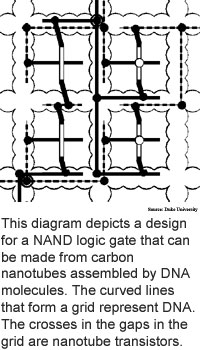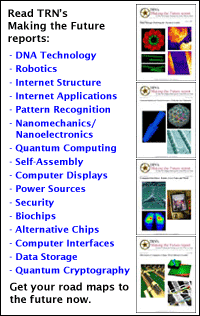
Tools design DNA-nanotube logic
By
Eric Smalley,
Technology Research NewsResearchers have recently begun to use DNA to assemble carbon nanotubes into transistors, the building blocks of computer circuits.
Biological DNA molecules, made from long strings of four types of bases attached to a sugar-phosphate backbone, hold instructions for making the proteins that enable life's processes. Artificial DNA molecules can be caused to self-assemble into various patterns, and can also be coaxed to attach to objects like carbon nanotubes. Given the right design, DNA molecules can assemble objects.
Carbon nanotubes are rolled-up sheets of carbon atoms that have useful electrical properties and can be 1,000 times smaller than an E. Coli bacterium. A nanometer is one millionth of a millimeter.
Researchers from Duke University are aiming to make the process of assembling molecular-scale components easier with a suite of computer-aided design (CAD) tools for designing computer circuits made from carbon nanotubes assembled by DNA.
Such self-assembled, molecular-scale circuitry could be used to make cheaper, higher-performance computers than are possible using today's silicon-based chipmaking technologies.
The researchers' tools make it possible to design computer circuits that could be assembled automatically by DNA, said Chris Dwyer, an assistant professor of electrical and computer engineering at Duke University. "Our tools enable the design and evaluation of the circuitry... based on a DNA self-assembly process and carbon nanotubes."
The tools are designed to build computer circuits at a density of 2,500 transistors per square micron, which is about 30 times more closely packed than devices made using current chipmaking technologies, according to Dwyer. A micron is one thousandth of a millimeter.
Transistors are arranged into logic gates, which in turn are combined by the millions into the complicated circuits that process and store data. Being able to assemble individual nanotube transistors is the prerequisite for developing a nanotube-based chipmaking technology. The key is finding ways to combine them into logic circuits.
The tools use a DNA scaffold recently created by another Duke University research team as the foundation for nanotube circuits. The scaffold is a self-assembled, grid-like fabric of DNA molecules. The grid's cavities measure 20 nanometers across.
The DNA scaffold technology is still being developed, said Dwyer. The scaffolding and tools are being developed in parallel; once the DNA scaffold technology is ready "we need the ability to reason about the performance of these devices, and the computer architectures they can lead to, [in order] to make high-level strategic decisions such as how to restructure the flow of information and how to execute computations," he said.
The researchers' DNA-nanotube circuit architecture uses pairs of complementary sequences of DNA to connect the ends of the carbon nanotubes to points on the DNA scaffold. Connecting a semiconducting nanotube across the middle of a cavity and a metallic nanotube across the cavity perpendicular to the first nanotube makes a field-effect nanotube transistor. The gate electrodes in field-effect transistors produce an electric field that changes the conductivity of the device's semiconductor channel.
The architecture also calls for attaching metallic nanowires along the DNA segments that make up the scaffold on both the top and bottom sides. To fill the gaps between the nanotubes at the intersections of the grid and the points where the transistor nanotubes connect to the grid, the architecture includes DNA sequences that attract metallic nanoparticles. Later in the process, the nanoparticles attract metal atoms to form a chemically-assembled solder.
Like traditional computer-aided design tools, the researchers' tools allow users to design individual devices like logic gates, connect the devices to form whole systems, generate a circuit layout, and produce a sequence of assembly steps. The assembly plan includes specific DNA sequences as well as the nanotube or nanoparticle component for each step.
The tools use specialized models that roughly gauge the performance of circuits based on the low-level behavior of nanotube transistors, said Dwyer. "With this evaluation we can estimate the speed and energy consumption of our designs; we use this to inform our decision-making process and high-level architectural simulators," he said.
In providing a framework for evaluating potential systems, they are similar to the first generation of design tools geared toward microelectronics that eventually lead to very large-scale integration (VLSI) computer-aided design tools, he said.
Nanoelectronics, and particularly the self-assembly process, require different ways of thinking about circuitry and how computations occur to make the best of the technology, said Dwyer. "Our tools provide a foundation for those future designs," he said. "Further down the road, we hope these tools will mature to the level that present-day very large-scale integration computer-aided design tools have -- this will make wider access to the new technology possible."
The researchers' next step is to use the tools in simple designs, said Dwyer. "We are currently assembling a simple DNA lattice that will eventually be suitable for a NAND gate," he said.
A NAND, or Not AND, gate is one of the basic building blocks of computer circuits. It contains two input signals and one output signal. If either of the input signals is a 1, the output is 0.
One challenge is that the larger the DNA scaffold, the greater the number of unique DNA sequences required to create circuits. The researchers are working on minimizing the overall number of required sequences, according to Dwyer.
The researchers' nanotech fabrication computer-aided design tools could be used to carry out nanotube construction in five to ten years, said Dwyer. Dwyer's research colleagues were Vijeta Johri, Moky Cheung, Jaidev Patwardhan, Alvin Lebeck and Daniel Sorin. The work is slated to appear in the September issue of Nanotechnology. The research was funded by the National Science Foundation (NSF) and Duke University.
Timeline: 5-10 years
Funding: Government; University
TRN Categories: Nanotechnology; DNA Technology; Integrated Circuits
Story Type: News
Related Elements: Technical paper, "Design Tools for a DNA-Guided Self-Assembling Carbon Nanotube Technology," Nanotechnology, September 2004
Advertisements:
August 25/September 1, 2004
Page One
Selective shutdown protects nets
Tools design DNA-nanotube logic
Five photons linked
Liquid crystal IDs pathogens
Briefs:
Photosynthesis drives solar cell
Hybrid nanowire makes transistor
Nanocrystals spark efficient LEDs
Nanotubes make fluid filter
DNA copier uses little power
Method makes stronger steel

News:
Research News Roundup
Research Watch blog
Features:
View from the High Ground Q&A
How It Works
RSS Feeds:
News
Ad links:
Buy an ad link
| Advertisements:
|
 |
Ad links: Clear History
Buy an ad link
|
TRN
Newswire and Headline Feeds for Web sites
|
© Copyright Technology Research News, LLC 2000-2006. All rights reserved.